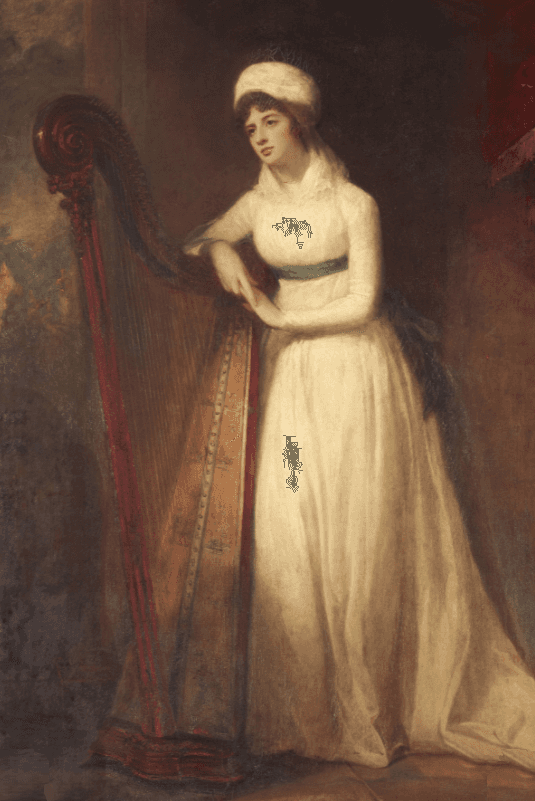Lady Louisa Hervey (1767-1821) was the third and youngest daughter of Frederick Augustus Hervey, 4th Earl of Bristol and Bishop of Derry (1730-1803). The Earl was a radical, supporting the Irish Volunteer rebel movement in 1782-3 and favouring both political and religious equality (for example, he objected to tithes, at that time the financial bulwark of the Church of England). In addition, Louisa's elder sister Elizabeth was the live-in mistress (and later wife) of the Whig 5th Duke of Devonshire. Louisa however was very different from her rakish father and sister; she was a diffident soul and an Evangelical, with a seriousness which appealed to Liverpool.
Liverpool met Louisa some time in 1793 and kept the relationship secret from his father in the early stages – needless to say, this did not improve his father's disposition when the truth was revealed. By November 1794 Liverpool's wooing had been successful; the pair then made the mistake of asking the Earl-Bishop's consent first (he was, as usual travelling on the Continent). This was returned with great benevolence. However, being left to last did nothing at all for Jenkinson's equanimity – he had indeed refused to believe a romance was in train when informed of it by a third party.
When Jenkinson was finally told officially, initially by a letter from Liverpool, he refused to accept the match, whereupon Liverpool, after consulting with Pitt and Dundas, informed his father that if thwarted in love he would be compelled to give up his Parliamentary career. As Pitt and Dundas agreed (according to the possibly malicious Canning) "the pride which he feels in his son's consequence is a passion much more powerful, and to which it is much more prudent to appeal, than his affection."1 Eventually even the King got involved, not entirely surprisingly given his 30-year friendship with Jenkinson, to persuade Jenkinson that in spite of the highly unsatisfactory character of the bride's father, true love should be allowed to prevail.
In the event, Liverpool's judgement proved admirable. Louisa was an excellent wife until her relatively early death in 1821, although the Liverpool household was notable for the dullness of its entertainments and the fashionable Whig hostess Lady Holland accused her of "extreme prudery."2 Although Lady Louisa often found the role of politician's wife tiring, she relished the excitement of attending functions and being close to great events. Loyal and supportive of her husband, she took a keen interest in his political work, and sometimes helped him by copying confidential documents, while his friend Thomas Lawrence thought Liverpool communicated much information to his wife and asked her opinion on many of his letters. Louisa was also a good judge of people; in particular she disliked and distrusted Canning, being thus a useful corrective to Liverpool's enthusiasm for him. It is notable that Canning's final apotheosis to the post of Foreign Secretary and Leader of the House of Commons occurred only in 1822, after Louisa's death.
Louisa’s health began to fail from 1816; she was seriously ill in the summer of 1820 and died at Fife House on June 12, 1821, aged 54
Liverpool’s love for Louisa was memorialized in a bust by Sir Francis Chantry3, which was to be completed in 1825 and remained at Coombe Wood until Liverpool’s death, after which it was placed in All Saints, Kingston-on-Thames. It is a fine marble bust of a young girl with a wistful expression, almost certainly taken from Romney’s 1793 portrait of Louisa. The inscription reads:
Louisa Theodosia
Countess of Liverpool,
Born February 1767
Died June 1821
She visited the fatherless
and widows in their affliction
and kept herself
unspotted from the world.4
[1] Quoted Gash, op. cit. p32.
[2] Quoted Gash, op. cit. p32. Elizabeth Fox nee Vassall (1771-1845) married 3rd Baron Holland in 1797, having been divorced 2 days earlier from her previous husband on grounds of her adultery. She had her 5 children with her first husband, 7 with Holland and introduced the dahlia to England. A bossy woman, she admired Napoleon and was admired by the Whig diarist Charles Greville but NOT by Mrs. Arbuthnot.
[3] Francis Leggatt Chantrey (1781-1841) R.A. 1818, Knighted 1835. Leading Regency sculptor. Left Chantrey Bequest, which was the main source of funding for acquisitions at Tate Britain until 1925.
[4] The wording is an adaptation of the Epistle of St James, I, 27 “Pure religion and undefiled before God and the Father is this: To visit the fatherless and widows in their affliction, and to keep himself unspotted from the world.”
